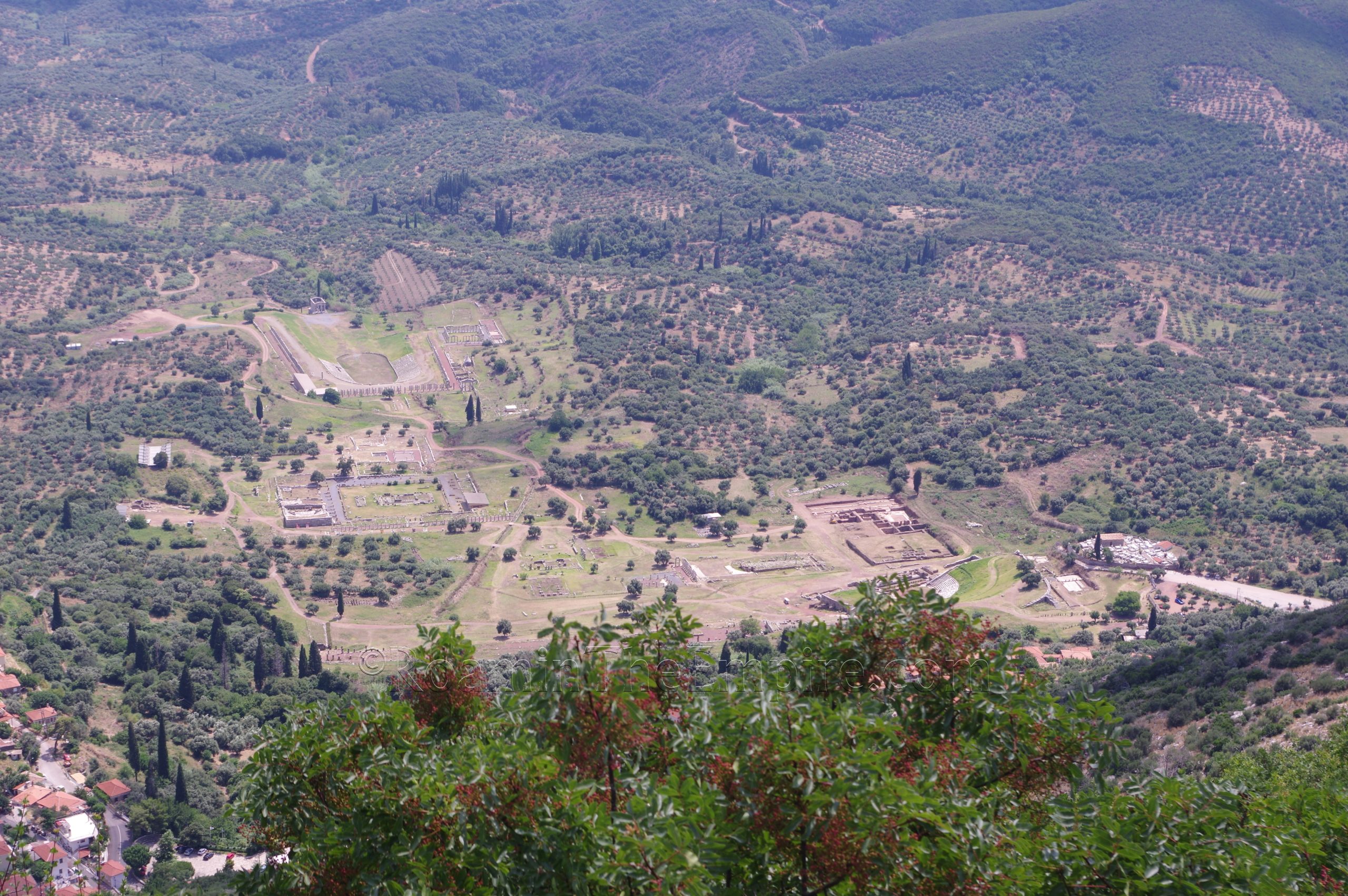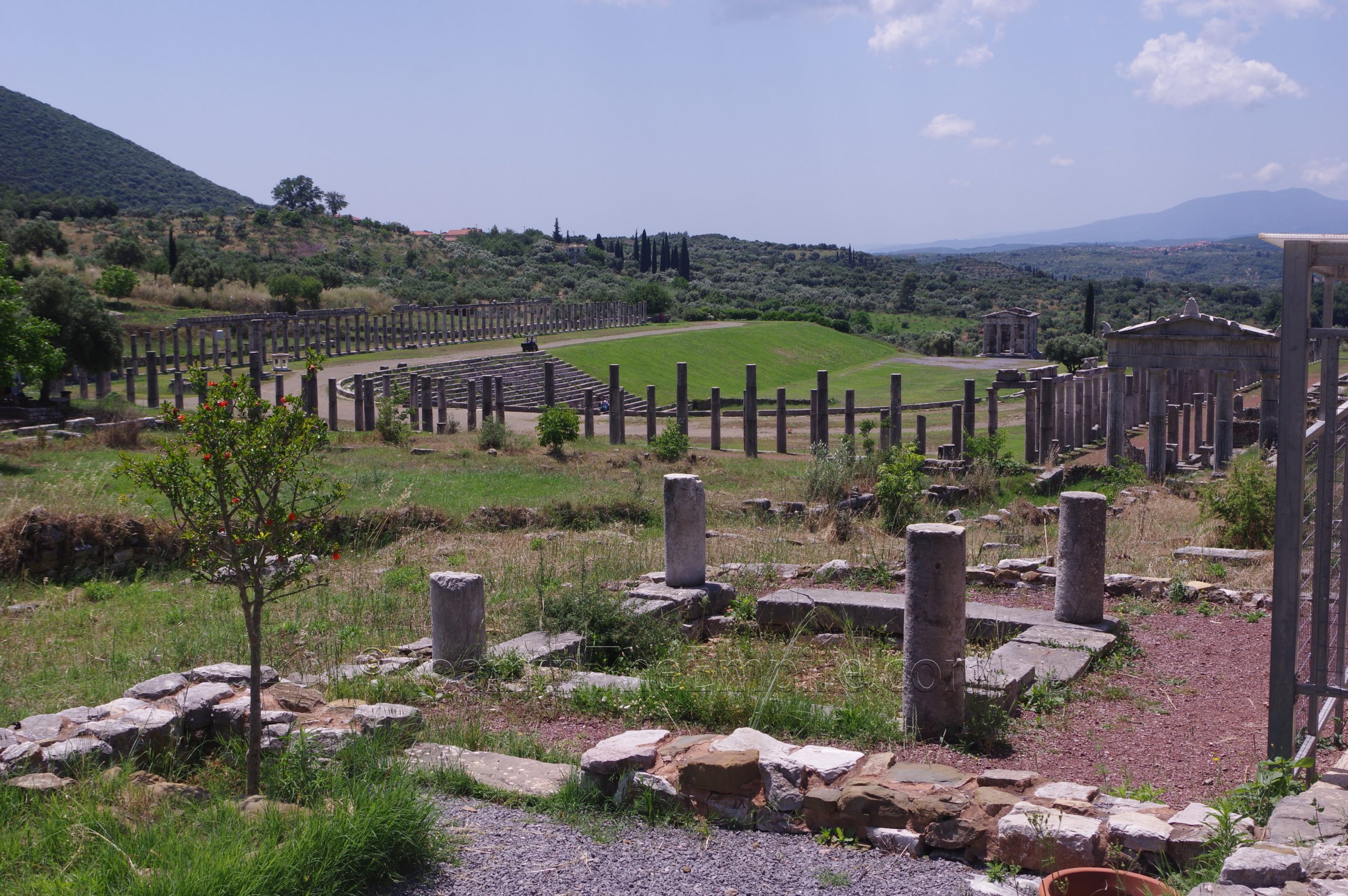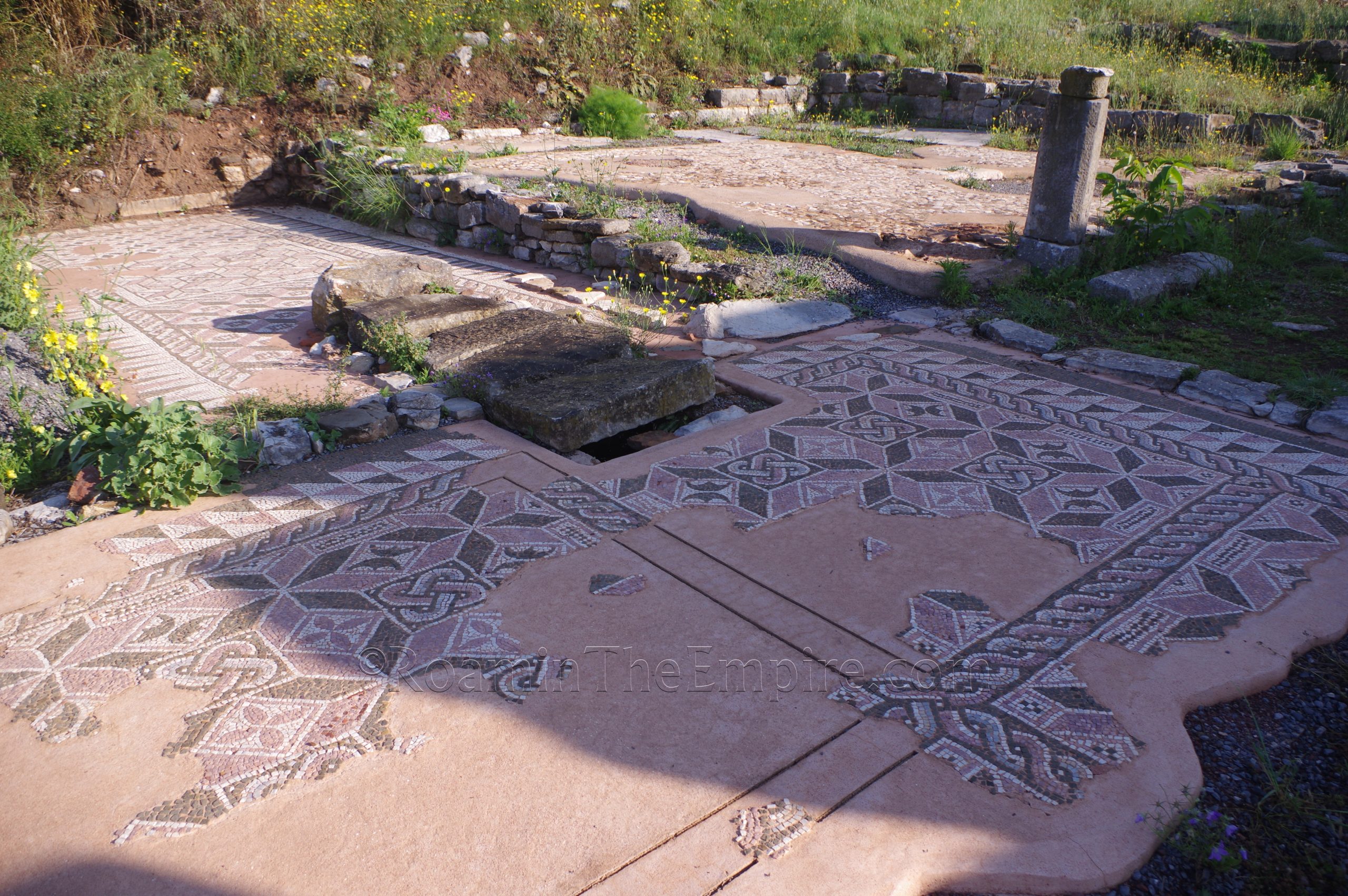
Most Recent Visit: July 2023
Prior to the foundation of the classical city of Messene in the 4th century BCE, the southern slope of Mount Ithome (Ithomi) was the location of a settlement that itself seems to have been named Ithome, which had been occupied since at least the Bronze Age. Messene was the name given to the larger region in which Ithome was located, though, and the Messenians were the population that inhabited the region. The First Messenian War in the late 8th century BCE between the Messenians and Spartans culminated in a siege of Ithome, where the Messenians may have held out for nearly 20 years before falling to the Spartans. This war seems to have resulted in significant land annexation by Sparta. A Second Messenian War followed in the 7th century BCE with another Spartan victory and the subjugation of the Messenians into Spartan hegemony as part of the helots. A third war and general helot revolt occurred following an earthquake in 464 BCE and once again saw the Messenians hold out for many years at Ithome before it once again fell to a Spartan siege.
After that Spartan victory, the Messenians were displaced from the region and resettled by the Athenians at Naupaktos (modern Nafpaktos). Around 399 BCE, following the Spartan victory in the Second Peloponnesian War, the Messenians were expelled from Naupaktos and further dispersed to Rhegium (modern Reggio Calabria) and Euesperides (modern Benghazi). The tide of wider Spartan hegemony turned with their defeat at the Battle of Leuctra in 371 BC and the subsequent Theban invasion of the Peloponnese. The Theban general Epaminondas, as part of his plan to curtail Spartan power on the peninsula, established the cities of Megalopolis and Mantinea in Arcadia, and the city of Messene at the former location of Ithome in 369 BCE. He invited the Messenians who had dispersed around the Mediterranean to return and populate the city and named it after the legendary queen Messana.

The city and a formidable set of fortifications that encompass the peak of Mount Ithome are allegedly constructed in just 85 days with the help of architects from all over the Greek world. Over the next century, Messene was frequently involved in military conflict in the Peloponnese. Sparta was still prone to military intervention on the peninsula. First the Messenians would mostly align themselves with their Theban benefactors, fighting against the Spartans at the Battle of Mantinea in 362 BCE, before shifting to allying with Athens and later Macedonia, who would expand the territory of Messene after the Battle of Chaeronea in 338 BCE. After the death of Alexander the Great, Messene initially remains loyal to the Macedonians, but joins the Hellenic League in the Lamian War and their unsuccessful bid to end Macedonian hegemony in Greece. Similarly, Messene is embroiled in the Wars of the Diadochi in the late 4th and early 3rd centuries BCE. Messene directly comes under siege at least once during this period, in 295 BCE by Demetrios Poliokertes, who is wounded in the action.

Following the Wars of the Diadochi, Greece saw the invasions of the Galatians in 279 BCE, in which Messene does not seem to have been involved, followed shortly after by the invasion of the Peloponnese by Pyrrhus of Epirus, which saw an unlikely alliance between Messene and Sparta. As conflict continues nearly constantly in Greece for the remainder of the 3rd century BCE and into the early 2nd century BCE, Messene vacillates their support between the competing Aetolian and Achaean Leagues; switching their allegiance several times. In 215 BCE, a movement for social and political reform in Messene leads to civil discord with many aristocrats being killed in the ensuing violence. The following year, the Macedonian general Demetrios of Pharos attempts to intervene in the internal dispute and capture Messene, but his attempt is unsuccessful and he is killed in the battle for the city. Philip V attempts a capture of the city as well, but similarly fails to do so.

At the same time, the Romans begin to get more directly involved in the region with the start of the First Macedonian War in 214 BCE. Having been attacked by Macedonia, Messene puts their support with the Roman-allied Aetolian League, leading to relatively friendly relations between Messene and Rome. Following the First Macedonian War, Messene is attacked and captured, save for the acropolis, by Nabis of Sparta in 201 BCE. The Achaean League forces Nabis to withdraw, though he loots the city. In 196 BCE, Titus Quintus Flaminius proclaims the freedom of the Greek cities. The following year Nabis runs afoul of the Romans and Messene joins in actions against Sparta, resulting in the defeat of Nabis and the return of spoils looted in 201 BCE. In 192 BCE, Messene and the Aetolian League ally with Antichous the Great of the Seleucid Empire against the Achaean League and Rome. Antichous is defeated in Greece the following year and the war ends in Rome’s favor in 188 BCE. Messene is compelled to join the Achaean League following this defeat.

Messene attempts to defect from the Achaean League in 183 BCE over territorial grievances that the league and Rome decline to address with seriousness. The famous Achaean League general Philopoemen was captured early in the revolt and given the option to commit suicide; a death that supposedly galvanized the Achaean League against Messene. Messene is captured in 182 BCE with the leaders of the revolt executed or compelled to commit suicide similar to Philopoemen. Messene remains with the Achaean League but declines to send troops when the league goes to war with Rome in 146 BCE. Following the Roman victory that same year, the consul Lucius Mummius awards a number of cities to the Messenians, and in 140 BCE favors Messene in a territorial dispute with Sparta. The latter decision is reversed in 44 BCE by Julius Caesar and Marcus Antonius, perhaps leading to Messene’s decision to support the liberatores in their conflict with Octavian following the assassination of Caesar. Similarly, Messene backed Marcus Antonius in his civil war against Octavian. The former brought no ill consequence on the Messenians, but the latter resulted in territory awarded to Sparta, who had supported Octavian.

Messene seems to be relatively prosperous in the early imperial period. An earthquake seems to have struck late in the reign of Augustus, necessitating the repair of many buildings. Nero visited the city in 67 CE and made the Messenians socii of the Romans. Starting in the early 3rd century CE, the city appears to have entered into a state of decline culminating in a destructive event, likely an earthquake, that seems to result in much of the city being abandoned around 360-370 CE. By the time of the Gothic invasions of the Peloponnese in 395 BCE, Messene was likely already mostly abandoned. It was reoccupied in the early Byzantine period, though.
Getting There: The closest town to the core remains of ancient Messene is Mavrommati, which is a relatively small town. The closest city of any consequence is Kalamata, which is about 45 minutes away by private vehicle. There are supposedly buses that run out there, but I couldn’t find any concrete information. It’s worth noting that there is a modern Messini near Kalamata, which enjoys frequent bus connections with Kalamata that should not be confused with the ancient archaeological site. Given that some of the interesting sites in the vicinity of Messene are also a fair bit from Mavrommati and the archaeological area, a private vehicle is overall the most efficient way to visit.
The Archaeological Site of Ancient Messene is located just to the south of Mavrommati; an unnamed road west of Mavrommati, next to the archaeological museum, leads south to the site. Messene is pretty well signed, even all the way back to the E55 highway, so it’s easy to find. There’s a parking area right near the museum, but to get to the site, follow the road until you basically can’t follow it anymore. The archaeological area is open in the summer (April through October) from 8:00 to 19:00 and the rest of the year from 8:30 to 15:30. Admission is 10 Euros and includes entrance to the museum.

The first major monument encountered, the south of the entry area, is the theater. But, to the west of the theater, below the robust retaining wall of the structure, is an area known as the Theater Quarters. Located here are domestic structures dating to the 3rd-4th century CE, built upon earlier Roman and Hellenistic buildings. The northern part of this area is dominated by two large rooms separated by a colonnaded wall, both of which are decorated by mosaic flooring. Both are mostly geometric mosaics with single inscriptions. In the north room, a very inconspicuous and simple inscription in a border along the south side of the room records the name of the episkopos (bishop) Theodoulos. In the southern room, the inscription is much more visible as the emblema at the center of the mosaic, recording the name and patronage of the mosaic of the anagnostes (reader) Paramonos. The implication of the two inscriptions would seem to indicate that the space was used as an early Christian gathering space, perhaps a domus ecclesiae. Opposite these rooms are a stairway in the retaining wall leads up to the theater.

To the south of these rooms are another series of what would appear to be later, likely Byzantine constructions. These partially overlaid a road that would have run along this side of the theater in the Greek and Roman periods of occupation. A small bit of this is visible between the theater retaining wall and the constructions. At the very south of the excavations here are a few more rooms decorated with geometric mosaics that date to the same period as the two larger mosaics in the north, as well as a room decorated with a coarser stonework more reminiscent of a very rough opus scutulatum. A bit of brickwork flooring is also visible in one area of this room. Adjacent to these rooms, another staircase leads up through the retaining wall to the theater, though the pointed stone arch over the entryway into the staircase is preserved here.
Continued in Messene, Achaea – Part II
Sources:
Baldassarra, Damiana. “La Famiglia di Damonikos di Messene.”Onomatologos: Studies in Greek Personal Names Presented to Elaine Matthews, R.W.V Catling and F. Marchand (eds.), Oxford: Oxbow Books, 2010.
Bourbou, Chryssa and Petros Themelis. “Child Burials at Ancient Messene.” L’Enfant et la mort dans l”Antiquité I. Nouvelles recherches dan les nécropoles grecques. Le signalement des tombes d’enfants, Ann-Marie Guimier-Sorbets and Yvette Morizot (eds.), Paris: De Boccard, 2010.
Diodorus Siculus. Bibliotheca Historica, 12.44.3, 15.66.
Eck, Werner. “Ein Zeichen Von Senatorischer Identität: Statuenehrungen Für Kaiser Mit Lateinischen Inschriften Aus Messene.” Zeitschrift für Papyrologie und Epigraphik, No. 202 (2017), pp. 255-262.
Grant, Michael. A Guide to the Ancient World: A Dictionary of Classical Place Names. New York: Barnes & Noble Books, 1997.
Kennell, Nigel M. “Cultural History and Memory in the Stadium-Gymnasium Complex at Messene.” American Journal of Archaeology, Vol. 125, No. 4 (October 2021).
Livy. Ab Urbe Condita, 36.3.
Luragji, Nino. “Meeting Messenians in Pausanias’ Greece.” Le Péloponnése D’Épaminondas À Hadrien, Catherine Grandjean (ed.), Pessac, France: Ausonius Éditions, 2008.
Luraghi, Nino. “Messenian Ethnicity and the Free Messenians.” The Politics of Ethnicity and the Crisis of the Peloponnesian League, Peter Funke and Nino Luraghi (eds.), Washington DC: Center for Hellenic Studies, 2009.
Pausanias. Hellados Periegesis, 4.1-33, 4.23.5.
Plutarch. Agesilaus, 34-35.
Plutarch. Aratus, 49-51.
Plutarch. Pelopidas, 30.5, 31.1.
Plutarch. Philopoemen, 12, 18-21.
Polybius. Historiai, 7.10-14, 9.30, 16.13-17, 23.12, 38.16.
Smith, William. Dictionary of Greek and Roman Geography. Walton & Murray, 1870.
Spathi, Maria. “The Sanctuary of Artemis Limnatis in Ancient Messene: An Overview of the Finds Assemblage.” CHS Research Bulletin 11 (2023).
Stillwell, Richard, William L. MacDonald, and Marian Holland. McAllister. The Princeton Encyclopedia of Classical Sites. Princeton, NJ: Princeton U Press, 1976.
Strabo. Geographica, 8.4.6.
Themelis, Petros “Artemis Ortheia at Messene.” Ancient Greek Cult Practice from the Epigraphical Evidence, Robin Hägg (ed.), Stockholm, 1994.
Themelis, Petros. “The Sanctuary of Demeter and the Dioscouri at Messene.” Ancient Greek Cult Practice from the Archaeological Evidence, Robin Hägg (ed.), Stockholm, 1998.
Themelis, Petros. “The Messene Theseus and the Ephebes.” Zona Archeologica. Festschrift für Hans Peter Isler zum 60 Geburtstag, Sabrina Buzzi (ed.), Bonn: Habelt, 2001.
Themelis, Petros. “Roman Messene. The Gymnasium.” The Greek East in the Roman Context, Olli Salomies (ed.), Helsinki: Bookstore Tiedekirja, 2001.
Themelis, Petros. Ancient Messene, Athens: Ath. Petroulakis, 2003.
Themelis, Petros. “Cults on Mount Ithome.” Kernos, Vol. 17 (2004), pp. 143-154.
Themelis, Petros. “The Cult of Isis at Ancient Messene.” Bibliotheca Isiaca, Vol. II (2011), pp. 95-107.
Themelis, Petros. “The Agora of Messene.” Tout Vendre, Tout Acheter. Structures et équipements des marchés antiques, Véronique Chankowski and Pavlos Karvonis (eds.), Pessac, France: Ausonius Éditions, 2012.
Themelis, Petros. “The Theater at Messene: Building Phases and Masons’ Marks.” The Architecture of the Ancient Greek Theatre, Monographs of the Danish Institute at Athens, Rune Frederiksen (ed.), Arrhus University Press, 2015.
Themelis, Petros. “Messene. From the Hellenistic to the Roman City.” Honorary Volume for Stella Drougou, Ministry of Culture and Sports Archaeological Resources and Expropriations Fund, Athens, 2016, pp. 541-556.
Themelis, Petros. “The Sculpture of Messene.” Handbook of Greek Sculpture, Olga Palagia (ed.), De Gruyter, 2019.
Themelis, Petros. “The Sanctuary of Messana: Organization of the Sacred Space.” Côtoyer les Dieux: l’organisation des espaces dans les sanctuaires grecs et romains, Sandrine Huber and William Van Andringa (eds.), Bibliothèque de l’École française d’Athènes, 2022.
Tsivikis, Nikos. “Architectural Planning and Building Practices at the Basilica of the Theater in Messene.” Deltion of the Christian Archaeological Society, Series 4, Volume 39 (2018).
Xenophon. Hellenica, 7.5.5.
Yoshitake, Ryūichi. “Building Phases of the Theatre at Ancient Messene.” Journal of Architecture and Planning, Vol. 84, No. 759 (May 2019), pp. 1259-1269.
Yoshitake, Ryūichi. “The Movable Stage in Hellenistic Greek Theaters. New Documentation from Messene and Comparisons with Sparta and Megalopolis.” Archäologischer Anzeiger, no. 2 (2016), pp. 119-133.
Yoshitake, Ryūichi. “Building Technique of the Theater at Ancient Messene.” Japan Architectural Review, Vol 4, No. 3 (July 2021), pp. 515-532.


